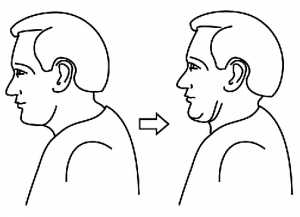

The first chin tuck variation occurs in the supine position, so lie on your back with a rolled-up towel under your neck at the base of your skull. Once you have this motion down, you can vary your chin tuck exercises and further challenge your intrinsic neck muscles. If you’re doing it right, you may even feel a stretch along the suboccipital muscles on the back of your head when your chin is tucked. The muscles you’re targeting aren’t large themselves, and by minimizing the movement, you’ll better engage the smaller flexor muscles in your neck.įinally, scapular retraction helps set the stage for proper chin tuck technique by bringing your head into neutral spine. Grated, it’s not a big movement-but it needn’t be. Your goal is to nod your head so that it spins along the rod-inwardly and downwardly. Now, imagine there’s a rod between your ears.This shoulder squeeze, or scapular retraction, naturally lifts your head to the correct starting position. First, sit or stand tall and squeeze your shoulder blades together on your back.To perform a chin tuck correctly, follow these steps: Without the right instruction, chin tucks are tricky to master, and they’re far less effective when they’re imprecise. What’s more, the sudden motion of retraction can actually cause an uncomfortable shearing force at the neck. Jutting your head back and forth will engage several neck muscles simultaneously, when really the goal behind the chin tuck is to engage the small, intrinsic flexor muscles deep inside the neck. But I’ve found this to be too aggressive for beginners-especially those with neck pain. Maybe you’ve seen another PT or trainer demonstrate chin tucks by jutting their head straight back. If those little muscles are stronger, you’ll be less likely to slump your head forward and slink back into kyphosis. Most importantly, a steady routine of chin tucks will help strengthen the neck’s intrinsic flexor muscles. Tucking the chin helps reverse kyphosis by putting the upper cervical vertebrae into flexion and the lower cervical vertebrae into extension. Prolonged poor posture-often characterized by a forward head and rounded shoulders-can lead to neck pain, a neck hump, and postural kyphosis, an abnormally curved spine. However, this small movement is powerfully effective at posture rehabilitation, which is why it’s so often recommended. Why Perform Chin Tucks?īy appearances, the chin tuck is a fairly underwhelming exercise with a self-explanatory name: to perform a chin tuck, you simply tuck your chin, over and over. By performing chin tucks regularly and correctly, you can improve your posture with less pain and more precision. But without a Physical Therapist at home, how can you be sure you’re doing them properly? In this article I’ll walk you through the dos and don’ts of chin tuck technique.

One of the best ways to eliminate neck pain and improve posture is to practice chin tucks.


 0 kommentar(er)
0 kommentar(er)
